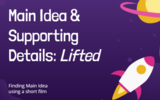
This is a great lesson to support learning about main idea and supporting details.
- Subject:
- English Language Arts
- Material Type:
- Homework/Assignment
- Author:
- Stacey Delk
- Date Added:
- 07/11/2021

This is a great lesson to support learning about main idea and supporting details.
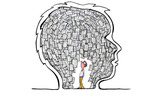
Main Idea and Supporting Details

Learners will identify sources of air pollution, explain the greenhouse effect, and detail procedures for improving and maintaining air quality. This represents a portion of the Introduction to Agriculture, Food, and Natural Resources (AFNR) series in Nebraska middle and high school agricultural education.
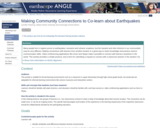
Many people live in regions prone to earthquakes, tsunamis and volcanic eruptions, but the hazards and risks inherent in our communities may be very different. Making connections with learners from another location is a great way to share knowledge and practice science communication skills. Video conferencing applications like Zoom and Skype make it possible to connect with learners anywhere in the world. This activity provides a simple protocol, and a form for submitting a request to connect with a classroom teacher in Anchorage, Alaska.
(Note: this resource was added to OER Commons as part of a batch upload of over 2,200 records. If you notice an issue with the quality of the metadata, please let us know by using the 'report' button and we will flag it for consideration.)
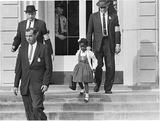
Goal/Objective:The students will construct meaning of an informational text while developing a multicultural perspective. Overview:This comprehension lesson focuses on a variety of reading skills, including making predictions and inferences, comparing/contrasting, answering inferential/critical questions, applying context clues and word structure to determine the meaning of words, and making text-to-self/text-to-world connections. All of these skills are taught alongside students learning about the Civil Rights Movement, the impact it has had on our nation, and the importance behind the story of Ruby Bridges.Grade Level:This lesson focuses on 4th grade standards, but can be adapted for any upper elementary classroom. Modifications/Accommodations:This lesson can be modified/accommodated for students with special needs. The lesson is derived from the ReadWorks.org website. If teachers create a free account to the website, students can have the passage, as well as the comprehension questions, read aloud to them.
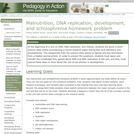
At the beginning of a DNA, DNA replication, and mitosis unit, students are given a short science news article summarizing a recent research paper. This assignment links the article to figures and key techniques from a related journal article, requiring students to apply and transfer the knowledge they gained in the unit.

Students will conduct research on common malware programs and infections.

LEARNING OBJECTIVESBy the end of this chapter, you will be able to:Understand the relationship between goals and time management.Consider how your priorities impact your time.Identify your time management personality.Assess your current use of time.Understand the basic principles of time management and planning.Use a calendar planner and daily to-do list to plan ahead for study tasks and manage your time effectively.Explore time management tips and strategies.Identify procrastination behaviors and strategies to avoid them.
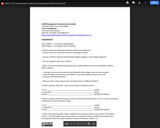
Assignments to accompany a course using Saylor Principles of Management textbook (https://saylordotorg.github.io/text_principles-of-management-v1.1).
Course Description
Introduces business management theory, including the basic functions of planning, organizing, directing, leading, and controlling as well as factors contributing to change in current management approaches. Recommended: BA 101, WR 121, and BA 131 or CAS 133. Prerequisites: WR 115, RD 115, and MTH 20 or equivalent placement test scores. Audit available.
Intended Outcomes
Upon successful completion of Management Fundamentals, the student will be able to:
Understand the overall role and importance of the management function.
Understanding the management process.
Communicate effectively using standard business terminology.
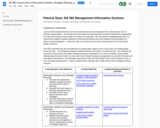
I use an OER textbook that has a lot of inconsistencies and uses examples from a fairly narrow slice of business organizations. Some topics feel very dated and are presented at a level of detail that is appropriate for a general business course (either too broad or too specific). My main goal for redesigning this unit is to improve the assigned reading materials so that they feel fresher and more relevant and accessible for a diverse student population. I teach this class in an online format, and it is important for me to have good written resources.
Learning Outcomes:
*Describe the relationship between strategic planning and information systems planning
*Describe the main steps in a strategic planning process
*Describe Porter’s three generic business-level strategies
*Describe information systems that can provide businesses with a competitive advantage
*Identify elements of a business process
*Identify how information systems and business processes work together to help an organization achieve its strategic objectives
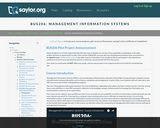
Management Information Systems (MIS) is a formal discipline within business education that bridges the gap between computer science and the well-known business disciplines of finance, marketing, and management.

The purpose of the resource is to produce a land cover type map from hard copies of Landsat satellite images.

Este cuadernillo de trabajo fue desarrollado como suplemento de la presentación "Mapping for Sucess: Alignment in the Spanish Heritage Curriculum" en el sexto Taller de Verano de TeCHS y presenta distintos modelos y prácticas efectivas para lograr la alineación de contenidos, actividades y evaluación en cursos de español como lengua de herencia. Los objetivos centrales son: comprender los desafíos que se presentan al crear o revisar un diseño curricular; explicar la importanción de la alineación como herramienta esencial del diseño curricular; y familiarizarse con el uso de mapas curriculares durante el proceso de diseño/rediseño de cursos de español.*Image: SpaceX Crew Dragon docking with the International Space Station. Public Domain. www.flickr.com/photos/nasakennedy/25097984792/
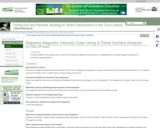
Provides students with an opportunity to work with and interpret magnetic intensity data (nT). Challenges them to explain magnetic intensity to an introductory geology student.
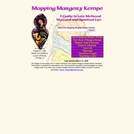
Margery Kempe's spiritual biography is often called the first autobiography in English. A married woman who attempted to live a life devoted to Christ, Margery sought official Church recognition for her status as a spiritual woman and mystic, while continuing to live and travel in the secular world. She experienced intense emotional visionary encounters with Christ, which have at times a strikingly homely quality. Her Book, dictated by her to a scribe, records these visions as well as her travels in Europe and pilgrimage to Jerusalem. Her particular spiritual trial, according to her Book, was to be misrepresented, persecuted, and rejected by many of her clerical and lay peers. The recording of her spiritual life, despite severe difficulties and her own illiteracy, became a symbolic act in itself, representing both her claim to spiritual status and evidence of her special relationship with God. Rich in detail about the people and places Margery encountered, the Book is a rich and fascinating record of life in turbulent early 15th century England. Mapping Margery Kempe is a digital library of resources for studying the cultural and social matrix of The Book of Margery Kempe. A goal of this site is to provide access to the material culture of Kempe's 15th century world, and especially the dynamic world of the parish. Materials at this site include a unique and extensive database of images of East Anglican parish churches. Other resources include the Middle English text and related devotional writings and saints' lives; documents about daily life, politics and commerce in 15th century Lynn; maps of pilgrimage routes; a gallery of devotional images; and bibliography and guides for teaching.
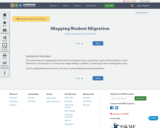
The content works for geography both human and physical and is a good way to get to know students in their freshmen or second year in a community college setting. In addition, students get used to working with maps. Courses: geography/world cultures and other courses dealing with world population.
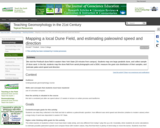
Students map one large hairpin parabolic dune in the Pinebush Preserve. They also profile the slopes on both proximal and distal sides of the dune. As a group, we take an ~ 2m long core of the dune sand to sample the sand beneath the soil profile. In the lab, students measure the particle size distribution of their sand samples, map the whole dune field from aerial photographs and a DEM, and estimate paleo-wind speed and direction. They then compare these data with modern wind data (available from the web) to answer the question of .just how different conditions were when the dune field was deposited
Uses online and/or real-time data
Addresses student fear of quantitative aspect and/or inadequate quantitative skills
Uses geomorphology to solve problems in other fields
(Note: this resource was added to OER Commons as part of a batch upload of over 2,200 records. If you notice an issue with the quality of the metadata, please let us know by using the 'report' button and we will flag it for consideration.)

This assignment is designed as a mini-research project with the purpose of having students engage with marginalized actors in history. The purpose is to help students find themselves in the archives by focusing on self-representation that is important to their own socio-economic and ethnic groups. By providing historical research in the form of primary and secondary documents on figures that have been historically "left out" of the historical narrative, the students will help fill the gaps in the archive, be active in the creation of new curriculum, and gain a better understanding of marginalization and the power of historical memory in the process.
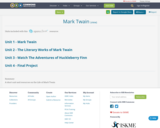
A short unit and resources on the Life of Mark Twain

what is marketing? 4 ps of marketing